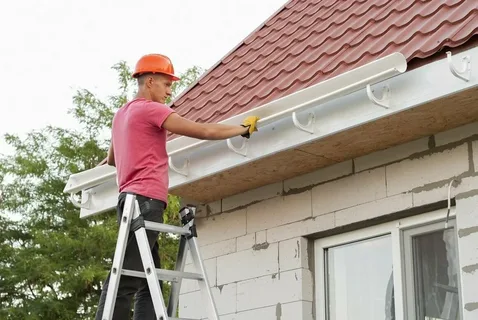Keeping your home safe from water damage starts from the top—literally. Rainwater might seem harmless, but without proper direction, it can cause serious issues for your house. That’s where gutter installation comes in. A professionally installed gutter system guides rainwater away from your home, helping to protect your walls, landscaping, and most importantly, your foundation. In this blog, we’ll explain why gutters matter, how they work, and what to expect from a quality installation.
Why Gutters Are Essential for Every Home
Gutters are more than just a roof accessory—they are a vital part of your home’s protection system. They collect and move rainwater away from your house to prevent problems like leaks, erosion, and basement flooding. Without them, water can pool around the base of your home and cause long-term damage.
Gutters also protect your siding, prevent mold growth, and help keep your home clean by avoiding splash-back during heavy rain. Overall, they help increase your home’s durability and value while reducing maintenance needs.
How Gutter Systems Work
A typical gutter system includes several important parts: the horizontal gutters that run along your roof edge, downspouts that direct water downward, and end caps or splash blocks to guide the water away. These parts work together to collect and move water safely away from your home.
During a storm, water flows from the roof into the gutters. From there, it travels through the downspouts and is directed away from your foundation. This simple system plays a big role in avoiding water-related problems inside and outside your house.
Benefits of Professional Gutter Installation
Getting a professional gutter installation offers more advantages than doing it yourself. Experts know how to properly measure and slope gutters so that water flows smoothly. They use strong, quality materials and install the system securely to handle different weather conditions.
Professionals also help you choose the best type of gutters for your home—whether it’s seamless, aluminum, or copper. This means you get a system that not only works well but also looks good and lasts longer. A properly installed gutter system can reduce future repair costs and offer peace of mind.
Choosing the Right Type of Gutters
There are many types of gutters available, and each has its own benefits. Choosing the right one depends on your home’s design, your budget, and the local climate.
Aluminum Gutters: Lightweight, rust-resistant, and affordable. They’re the most common choice.
Copper Gutters: Durable and stylish. Great for historic homes or elegant designs.
Vinyl Gutters: Easy to install and low-cost. Best for mild climates.
Steel Gutters: Strong and long-lasting. Perfect for areas with heavy rain or snow.
A gutter expert can help you decide which option suits your home best and make sure the size matches your roof’s needs.
Signs You Need New Gutters
How do you know it’s time for a new gutter installation? Look for these common warning signs:
- Cracks or holes in your gutters
- Rust or peeling paint around your home’s base
- Water spilling over the sides
- Pooling water near your foundation
- Mold or mildew in your basement
If you notice any of these issues, it may be time to replace your gutters before they cause further damage to your property.
The Gutter Installation Process
Understanding what happens during gutter installation can help you prepare and make the right choices. Here’s what usually happens:
Step 1: Inspection and Planning – A technician inspects your roof and foundation. Then they help plan the best layout and material.
Step 2: Measuring and Cutting – Gutters are measured to fit your roof and are cut to the right size. This ensures a clean, custom fit.
Step 3: Mounting the Gutters – Gutters are securely attached to the roof using brackets and hangers. The system is sloped slightly so water flows easily.
Step 4: Installing Downspouts – Downspouts are added to carry water from the gutters to the ground. Splash blocks or extensions help lead water away.
Step 5: Final Check – The installer tests the system and makes sure everything is working correctly.
Gutter Guards and Maintenance Tips
After a successful gutter installation, it’s important to keep the system working well. Gutter guards are one way to reduce how often you need to clean them. These covers stop leaves, dirt, and debris from blocking the flow of water.
You should still check your gutters at least twice a year. Clean them in the spring and fall, and after big storms. Make sure downspouts aren’t blocked and look for signs of wear or sagging. Regular maintenance extends the life of your gutters and protects your home.
How Gutters Protect Your Foundation
Your foundation is one of the most important parts of your house. Without working gutters, rainwater can collect around the base of your home. Over time, this water can seep into the ground and weaken the foundation walls.
Gutter installation directs water away from these critical areas. This helps avoid cracks, soil erosion, and costly structural repairs. A good gutter system is one of the smartest ways to keep your home’s base strong and stable.
Final Thoughts
A quality gutter installation is one of the best investments you can make in your home. It keeps rainwater under control, protects your foundation, and helps maintain the beauty and value of your property. With the right materials and a trusted professional, your gutter system will serve you well for years.
Don’t wait until water damage appears. Take action now and protect your home with a reliable, expertly installed gutter system.

